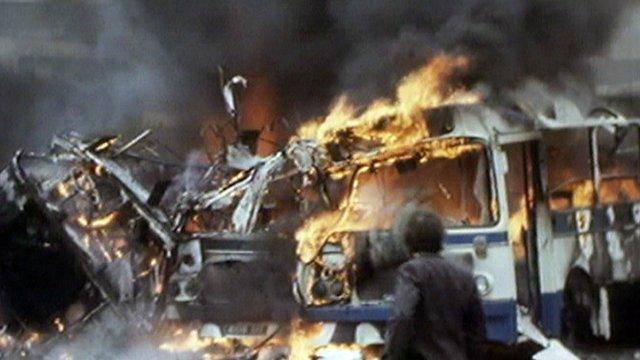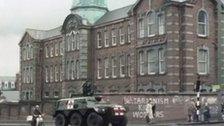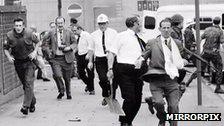Bloody Friday: How the Troubles inspired Belfast’s medical pioneers
- Published

Buses explode in Belfast
On Friday 21 July 1972, 19 Provisional IRA bombs ripped through the calm of a balmy Belfast afternoon.
In little over an hour, nine people were killed and 130 were injured. This day of carnage became known as <link> <caption>'Bloody Friday'</caption> <altText>Bloody Friday archive</altText> <url href="http://www.bbc.co.uk/history/events/bloody_friday_belfast" platform="highweb"/> </link> .
As sirens wailed and smoke rose above the city, the injured began arriving at Belfast's Royal Victoria Hospital.

Royal Victoria Hospital in the 1970s
War zone
'The Royal', as it is known locally, was then housed in an unassuming Victorian building in west Belfast, less than a mile from the city centre.
It would become world-renowned for ground-breaking emergency management and innovative surgical techniques, honed during years of conflict in Northern Ireland. This was a hospital with a war zone on its doorstep.
But the demands of Bloody Friday tested even the Royal's surgeons, nurses and students to the limit.
Dennis Coppel worked in the Intensive Care Unit (ICU) on that day. The echo of the bombs was enough to put his team on alert. When he arrived at the already overwhelmed Accident and Emergency department, he had no idea of the terrible scene that would greet him, or when it would end.

People flee bomb blast
Horrific injuries
As the timed devices went off around the city, the explosions destroyed much more than Belfast's buildings. Flying glass and debris from the blasts caused deep lacerations to people caught in the open. The powerful bombs blew off limbs and the resultant fireballs caused horrific injuries.
Lynn Lilburn, daughter of victim Jack Campbell, described her father's injuries.
"He was practically unrecognisable. His teeth were blown out, his arms were broken, his legs were broken, his ribs were broken. A lot of skin on his body had been blown off, the jelly in the back of his eyes had been shaken up … but he was just about alive."
As the emergency services arrived at the aftermath of the deadliest of the explosions, a car bomb within Oxford Street Bus Station, the scale of the disaster became clear.
Bobby Lambe, an ambulance worker, remembered one victim in particular.
"We were told to stand by and that we would have to take these people to the Royal to get them certified. When we got to the Royal one of them was so badly injured that they had to get a special doctor down to look at [them] to try and make up his mind whether it was male or female."
Disaster plan
Dr William Rutherford was a consultant surgeon in A&E at the Royal. He had recently put in place the hospital's first disaster plan, which was later adopted as a template for hospitals around the UK. His highly efficient 'triage' system meant patients were seen by the right surgeons in the right order, wasting as little time as possible.
Dr Rutherford had seen sectarian violence before. He spent 20 years in India as a medical missionary where he witnessed the violence of partition with Pakistan, where thousands died. He was a calming and authoritative presence on Bloody Friday.
"When the place was overwhelmed by patients and relatives, his work and organisational skills were second to none," recalled Dr Coppel.
Three years previously, few of the hospital staff had even seen a gunshot wound. By the end of 1972 - the bloodiest year of the Troubles, claiming 479 lives and many more injured - they had dealt with casualties on a scale that no one could have imagined.
Dennis Coppel estimated that the Royal was home to 95% of Northern Ireland's medical specialties during the Troubles. This concentration of charismatic and talented experts was key to the hospital's success.
Necessity drove innovation. The surgeons in the Royal became world famous for the techniques and procedures which they invented under the intense pressure of dealing with events like Bloody Friday.
Blast lung
One injury became known as 'blast lung'. As a result of an explosion, trauma to the chest caused the lungs to fill with blood and other fluids. It remains a common cause of death in bomb victims.
"We had quite a number of patients coming in with this 'blast lung' … no one had seen it before," said Dr Coppel.
The solution was to keep the lungs slightly inflated at the end of a breath to prevent collapse and further damage - a method known as 'positive end expiratory pressure' or PEEP. This is a technique now widely used around the world.
"It hadn't been used anywhere else and it improved oxygen levels in the patients to buy time," said Mr Coppel.
Innovation
Another innovator at the Royal was Aires Barros D'Sa, was a consultant who pioneered the management of complex injuries.
Barros D'Sa achieved international recognition for his development of the 'shunt', a means of diverting blood flow around serious injuries. He was also famed for his dexterity and coolness under pressure.
His wife Elizabeth, an anaesthetist at the Royal, explained: "There could have been a bit of conflict between the vascular surgeons and the orthopaedic as to who got to work on the patient first.
"It would obviously be most important to restore blood supply … however, if this was done first it stood a very good chance of being disrupted by the vigorous manipulations necessary to get the bones reset. Aires developed a system … allowing the leg to be manipulated while still maintaining the blood flow."
The methods he pioneered at the Royal remain the basis of treatments of wounded soldiers in modern conflicts such as the war in Afghanistan.
Titanium plates
Even dentistry played its role in an unusual collaboration that paradoxically resulted in explosives being used to repair the damage caused by explosives.
Derek Gordon was a neurologist at the Royal and good friends with Dr Gordon Blair, a dentist. Blair was already using titanium on teeth.
Neurosurgeon Dermot Byrnes worked under Dr Blair during the Troubles.
"They developed a technique which allowed the titanium to be moulded by explosives … [it] allowed the moulding of this very fine but extremely strong metal," he said.
"This [collaboration] forged an alliance between the doctors ... cooperation flourished and the buzz and job satisfaction from this was tremendous."
Security breaches
If it wasn't enough that the staff of the Royal were dealing with incredible pressure during the Troubles, violence also spilled over into the hospital.
"You had to protect patients from the gunmen," explained Dennis Coppel.
"We had an IRA man who was strapped up with fractures. The IRA came in one night and cut him down and took him away."
On another occasion, he recalled a soldier being shot in a corridor.
The problem became so bad that Dr Coppel eventually wrote to the prime minister.
"I wrote to Margaret Thatcher and explained the problems of security in the hospital. She replied 'Whatever needs to be done will be done'. Very quickly we got a proper secure unit - bulletproof windows and doors and guards."
Forty years on, Bloody Friday still stands out as one of Northern Ireland's darkest days. It was a time of unimaginable terror for the victims and extreme pressure for the emergency services. It is down to the skill and innovation of the doctors and staff at the Royal that many more didn't die that afternoon.
Their lasting legacy is the ability to turn the horror of events like Bloody Friday into positive medical advances that, to this day, continue to save lives and restore broken bodies.
A <link> <caption>documentary telling the story of Bloody Friday</caption> <url href="http://www.bbc.co.uk/programmes/b01kxsxn" platform="highweb"/> </link> was shown on BBC Northern Ireland on 19 July at 21:00 BST.